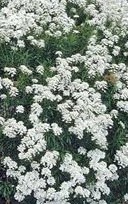 White flowers in the garden have many virtues. They make the garden look bigger and create a sense of spaciousness. They go with flowers of all other colors and can be a transition from one color to the next. Placed next to a plant with pastel colored flowers they soften the effect; placed in a dark area, they brighten it. If you want to make a plant “pop” put white flowered plants next to it, or if you enjoy your garden most at night use lots of white flowered plants and see how they almost glow in the moonlight.
White flowers in the garden have many virtues. They make the garden look bigger and create a sense of spaciousness. They go with flowers of all other colors and can be a transition from one color to the next. Placed next to a plant with pastel colored flowers they soften the effect; placed in a dark area, they brighten it. If you want to make a plant “pop” put white flowered plants next to it, or if you enjoy your garden most at night use lots of white flowered plants and see how they almost glow in the moonlight.
Here are five excellent spring blooming perennials for the rock garden that feature white flowers.
 Nana Alba Fan Columbine (Aquilegia flabellate var. nana alba)
Nana Alba Fan Columbine (Aquilegia flabellate var. nana alba)
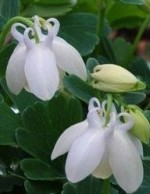 The unique flowers of columbines are always pleasing in the garden and fan columbine has especially endearing ones. Consisting of five petals and a projecting tube, the flowers are nodding and bear spurs that are conspicuously hooked. Nana alba is a dwarf form and grows into an attractive small compact mound, with flowers in mid- to late- spring. The dark blue-green leaves are relatively thick and are divided into three rounded, fan-shaped leaflets.
The unique flowers of columbines are always pleasing in the garden and fan columbine has especially endearing ones. Consisting of five petals and a projecting tube, the flowers are nodding and bear spurs that are conspicuously hooked. Nana alba is a dwarf form and grows into an attractive small compact mound, with flowers in mid- to late- spring. The dark blue-green leaves are relatively thick and are divided into three rounded, fan-shaped leaflets.
-
Size: 4-6” H x 6” W
Light: Sun to light shade
Soil :Average, well-drained with gravel mulch
Hardiness: Zones 3-9
 ‘Flora Plena’ Wall Rock Cress (Arabis caucasica ‘Flora Plena’)
‘Flora Plena’ Wall Rock Cress (Arabis caucasica ‘Flora Plena’)
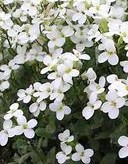 The double flowers make this rock cress one of the best for rock gardens. The flowers are sterile so the plant blooms profusely over a six week bloom time. A native of the Mediterranean, wall rock cress has thick succulent leaves and looks great climbing over rocks.
The double flowers make this rock cress one of the best for rock gardens. The flowers are sterile so the plant blooms profusely over a six week bloom time. A native of the Mediterranean, wall rock cress has thick succulent leaves and looks great climbing over rocks.
-
Size:8-10” H x 18” W
Light: Sun to light shade
Soil: Lean, well-drained
Hardiness: Zones 4-7
 Candytuft (Iberis sempervirens)
Candytuft (Iberis sempervirens)
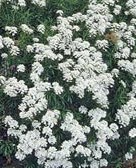 This old favorite offers dense mounds of evergreen foliage covered with white flowers for a long bloom time in spring. Some cultivars such as ‘October Glory’ and ‘Autumn’ Snow’ may rebloom in the fall. Small cultivars like ‘Little Gem’ at only 5-8” tall are best for small rock gardens.
This old favorite offers dense mounds of evergreen foliage covered with white flowers for a long bloom time in spring. Some cultivars such as ‘October Glory’ and ‘Autumn’ Snow’ may rebloom in the fall. Small cultivars like ‘Little Gem’ at only 5-8” tall are best for small rock gardens.
-
Size:9-12” H x 18” W
Light: Full sun
Soil: Average, well-drained
Hardiness: Zones 4-9
 Roof Iris (Iris tectorum var. alba)
Roof Iris (Iris tectorum var. alba)
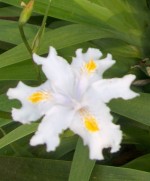 The flowers of roof iris are unlike those of the more common German iris but are extremely attractive. The falls and standards are similar and open equally so that a flat flower results. Roof iris belong to the crested iris (rather than beareded) group and var. alba has bright yellow crests. The evergreen foliage is attractive although a bit floppy. Roof iris is a heavy feeder and needs a balanced fertilizer in spring. The common name of this unique iris comes from the fact that they were grown on the edges of thatched roofs in Japan.
The flowers of roof iris are unlike those of the more common German iris but are extremely attractive. The falls and standards are similar and open equally so that a flat flower results. Roof iris belong to the crested iris (rather than beareded) group and var. alba has bright yellow crests. The evergreen foliage is attractive although a bit floppy. Roof iris is a heavy feeder and needs a balanced fertilizer in spring. The common name of this unique iris comes from the fact that they were grown on the edges of thatched roofs in Japan.
-
Size:12-18” H x 18” W
Light: Full sun; some shade is tolerated
Soil: Fertile, well-drained
Hardiness: Zones 4-9
 Pasque Flower (Pulsatilla vulgaris var. alba)
Pasque Flower (Pulsatilla vulgaris var. alba)
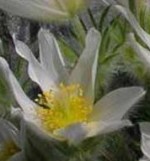 You get a double treat with this one. The creamy white flowers appear in early spring on leafless stems and are followed by silky seed heads that persist for weeks. Deeply and finely cut silky leaves provide a strong contrast to the flowers. Plants do not transplant well once they have become established and develop a deep root system.
You get a double treat with this one. The creamy white flowers appear in early spring on leafless stems and are followed by silky seed heads that persist for weeks. Deeply and finely cut silky leaves provide a strong contrast to the flowers. Plants do not transplant well once they have become established and develop a deep root system.
-
Size:4-6” H x 8” W
Light: Full sun; part shade in South
Soil: Average, well-drained; often found in calcareous soils.
Hardiness: Zones 5-8
All of the plants are of short stature, a common characteristic of rock garden plants. Similarly, all need well-drained soil. Wall rock cress needs lean soil, roof iris needs fertile soil, and the other three plants do well in average soil. Candytuft, like most rock garden plants, does best with full sun but pasque flower likes some shade in the South, while wall rock cress and fan columbine tolerate some shade. All of these plants do best in cool weather but candytuft, roof iris, and fan columbine will survive heat better than pasque flower or wall rock cress.
